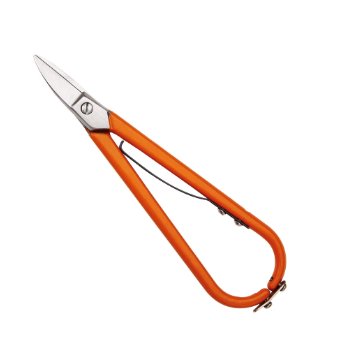Understanding Tin Metal Snips: Types and Capabilities
AVIATION SNIPS vs. Tinners: Key Differences
Aviation snips and tinners are both essential metal cutting tools, but they serve different purposes, primarily due to their ergonomic designs and functionalities. Aviation snips stand out with their color-coded handles – green for left cuts, red for right cuts, and yellow for straight cuts – simplifying the selection process for cutting different metal types. Featuring compound lever mechanisms, they are designed to exert more force with less effort, allowing them to cut through tougher materials effortlessly. On the other hand, tinners rely on a single pivot point, making them ideal for straight cuts and handling lighter metals.
The blade design plays a crucial role in enhancing cutting efficiency for both tools. Aviation snips usually have serrated blades, which prevent material slippage, making them suitable for curved and precision cuts. Meanwhile, tinners have straight blades positioned for longer and straighter cuts. As for cutting capacity, aviation snips have the edge when working with thicker and harder materials, thanks to their compound leverage, while tinners excel in projects that do not require significant force, such as crafting lightweight sheet metals into flat designs.
A practical choice between the two comes down to the project requirements. For example, aviation snips are preferred in HVAC work or automotive repair, where the ability to follow complex, circular patterns is vital. Tinners, tauted for their straightforward efficiency, are often the go-to for cutting extensive straight lines in thinner materials. Professional recommendations by industry standards often favor aviation snips for their versatility, especially when intricate cuts are needed, highlighting their preference among professionals and DIY enthusiasts, affirmed by recent surveys.
Ideal Applications for Tin Snips in Metalwork
Tin snips are versatile tools used across various industries, from HVAC installations and automotive repairs to metal artwork creation. Their manual design makes them particularly valuable for projects requiring precision without the bulkiness of power tools. In HVAC work, tin snips are perfect for cutting ductwork to exact specifications. Automotive professionals utilize them for trimming metal sheets and panels without leaving jagged edges, while artisans use them to shape and carve intricate metal designs.
When cutting thin sheet metal, tin snips offer clean results. To achieve impeccable edges, it’s essential to maintain a consistent cutting motion, ensuring that the snips remain aligned with the cutting path. Taking advantage of the serrated edges can also help control the material as you cut, reducing the risk of unwanted twisting or bending. Moreover, tin snips shine in environments where power tools can't reach, such as tight spaces or detailed work in sculptural metal art, where control and maneuverability are prioritized over speed and power.
Supporting this preference, a significant percentage of metalworkers advocate for manual tools like tin snips to maintain precision, especially for tasks where meticulous detailing is vital. Recent surveys indicate a growing trend where professionals favor tin snips for jobs requiring dexterity and fine control, underscoring the superiority of hand tools for intricate metalwork tasks. This emphasizes their continued importance amidst a landscape filled with advanced mechanical cutting solutions.
Common Alternatives to Tin Metal Snips
Hacksaws: Manual Cutting for Thicker Metals
A hacksaw is a versatile tool renowned for manual cutting across various materials including metal, plastic, and wood. Its defining feature is the fine-toothed blade held in an adjustable frame, allowing it to cut through materials such as steel, aluminum, and copper. Hacksaws are particularly valued for their affordability and ability to deliver precise straight cuts. However, using a hacksaw can be labor-intensive, especially when working on larger projects, and is generally limited to straight cuts.
Comparatively, hacksaws may not match the speed and efficiency of tin snips, especially when making quick cuts on thin metal sheets. Nonetheless, the hacksaw's versatility for tougher and thicker materials should not be underestimated. To maximize efficiency with a hacksaw, selecting the right blade type for the metal involved is essential. For instance, blades with larger teeth are more suitable for softer metals, while fine-toothed blades offer precise cutting for harder materials. Industry experts often recommend hacksaws for projects that require tougher material cutting, highlighting their adaptability and durability in varied environments.
Angle Grinders: Power Tool Versatility
Angle grinders are powerful tools extensively used in industries like construction and metal fabrication. These tools, equipped with a rotating abrasive disc, are adept at cutting, grinding, and polishing metals including steel, stainless steel, and aluminum. The primary advantage of angle grinders is their power and speed, which can significantly reduce the time required to cut through tough metals compared to manual tools. Despite these benefits, it's crucial to consider the precision limitations inherent to angle grinders, as they may not be ideal for intricate cuts.
Safety is a paramount concern when using angle grinders, necessitating the use of protective gear, such as gloves and goggles, and thorough training on its operation. In terms of user satisfaction, angle grinders score high for effectiveness, particularly for bulk cutting and remodeling tasks. Professional metalworkers often favor these tools for their versatility and efficiency in handling various materials, making them a staple in many workshops.
Plasma Cutters: Industrial-Grade Precision
Plasma cutters represent the pinnacle of precision in cutting thick metals at an industrial scale. Using a high-temperature plasma arc, they effortlessly slice through conductive metals, offering speed and versatility in metal fabrication. Plasma cutters are particularly advantageous when compared to tin snips in scenarios requiring detailed and high-volume work, providing precise and clean cuts with minimal kerf.
However, the cost of plasma cutters and the initial investment required can be a drawback for smaller-scale operations. In contrast to tin snips, which are suited for thin gauge materials, plasma cutters are designed for more robust applications, integrating speed and automation features that enhance productivity. The growing popularity of plasma technology in industrial settings is supported by industry studies, indicating a trend toward automation and precision.
Precision vs. Power: Performance Comparison
Curved Cuts and Tight Spaces: Snip Advantages
Tin snips excel at making curved and intricate cuts, making them indispensable for projects that require detailed metalwork or for DIY enthusiasts working on smaller tasks. The maneuverability of tin snips is unmatched by many power tools, especially when working on complex shapes or in tight spaces where precision is crucial. For instance, when crafting elaborate designs or working within confined areas, snips enable a controlled cutting experience that power tools can’t match. Moreover, using tin snips often results in faster completion times for delicate tasks, offering clear benefits over heavier machinery.
Speed and Thickness: Where Power Tools Dominate
In scenarios where cutting speed and material thickness are the primary considerations, power tools such as angle grinders and plasma cutters significantly outshine tin snips. Many power tools can slice through tougher metals with remarkable efficiency, making them a go-to choice for industrial settings or projects with tight deadlines. Matching the right tool to the right project is vital; electrical tools offer unparalleled speed and efficiency for bulk cutting, as illustrated through industry case studies. Users often report increased workflow efficiency and satisfaction when leveraging power tools for larger or more demanding tasks, underscoring their value in professional metalworking environments.
Material Compatibility Considerations
Thin Sheet Metal: Snip Superiority
Tin snips are unmatched when dealing with thin sheet metals like aluminum and steel because they offer superior precision and clean edges. Their design allows for meticulous cutting without deforming the material, which is crucial for projects where aesthetics and precision are priorities. In contrast, power tools are often too aggressive, leading to warping or damaging thin metals. Tin snips are especially effective for cutting sheet metals under 18 gauge, which is commonly used in ductwork and roofing. Industry guidelines suggest that thicker sheets requiring tin snips should be handled carefully for optimal cut quality. Therefore, for tasks demanding high precision and minimal distortion, tin snips are the go-to tools, offering a controlled and steady hand that power tools simply can't replicate.
Heavy-Gauge Metals: Alternative Tool Requirements
Cutting heavy-gauge metals presents challenges that tin snips are not equipped to handle, often necessitating stronger and more specialized tools. For these thicker materials, alternative tools like plasma cutters or industrial-grade saws provide the necessary power to cut through without compromising the quality of the workpiece. These tools require significant strength and advanced techniques to ensure a clean and efficient cut, making them more suitable for industrial applications. The increasing use of machines like plasma cutters in industries is supported by findings that demonstrate their efficiency and effectiveness in handling such tasks. As the demand for handling thicker metal materials rises, investing in heavy-duty tools becomes essential for professionals tackling robust projects.
Choosing the Right Tool for Your Project
Assessing Cut Complexity and Volume
When choosing the right cutting tools for your metalworking project, it's crucial to evaluate your project requirements carefully. Begin by understanding the type of cuts you need to make—whether they are straight, curved, or intricate. Each cut complexity may require different tools; for instance, straight cuts may favor shears, while intricate shapes might be better executed with snips. Additionally, consider the volume of cuts required. Projects demanding high-frequency cutting might benefit more from the efficiency of power tools, while low-volume or detail-oriented tasks might be best suited to manual tools like tin snips. Statistically, many users opt for aviation snips for their versatility in handling complex cuts, showcasing a preference when cut complexity increases.
Budget vs. Long-Term Utility
Budget is often a key determining factor in selecting cutting tools, and it must be balanced against the long-term utility of the investment. For those on a tight budget, tin snips can be an affordable one-time purchase that serves well for many simple cutting tasks. However, if your projects involve frequent or heavy-duty cutting, investing in durable power tools may prove more cost-effective over time. It's essential to consider maintenance and durability, as well-made tools can significantly reduce long-term project costs by outlasting their cheaper counterparts. Market research indicates that while the initial outlay for power tools can be steep, their longevity and versatility often justify the expense, making them a valuable investment for sustained use.
FAQ
What are aviation snips used for?
Aviation snips are primarily used for cutting different metal types, especially in projects that require complex, circular patterns. They are preferred in industries like HVAC work and automotive repair.
How do tin snips differ from power tools?
Tin snips are manual cutting tools ideal for precision and detailed metalwork. They are unmatched in tight spaces where power tools cannot reach, offering control and maneuverability over speed and power.
Why are plasma cutters considered the pinnacle of precision?
Plasma cutters use a high-temperature plasma arc to slice through conductive metals with precision, speed, and efficiency, making them ideal for detailed and high-volume work in industrial settings.
What should I consider when choosing the right cutting tool?
Consider the complexity and volume of cuts your project requires, and balance your budget against the long-term utility of the tools. Aviation snips and power tools each offer distinct advantages depending on the task.
Are hacksaws suitable for precision work with metals?
Yes, hacksaws are valued for their affordability and ability to deliver precise straight cuts on thicker metals. However, their labor-intensive nature and limitation to straight cuts make them less efficient than other tools for speed.


